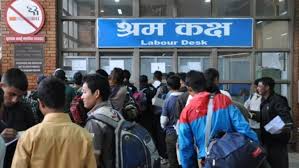Nepal to face labour shortage by 2030
 Kathmandu / October 27 : Nepal may face shortage of 3.6 million workers by 2030 if people continue to take up jobs in foreign labour markets, creating hurdles for nation’s transformation into a middle-income economy in the next 13 years as envisaged by the government, a latest report says.
Kathmandu / October 27 : Nepal may face shortage of 3.6 million workers by 2030 if people continue to take up jobs in foreign labour markets, creating hurdles for nation’s transformation into a middle-income economy in the next 13 years as envisaged by the government, a latest report says.
The projection was made on the basis of supply and demand of labourers in the coming years, and past economic and labour productivity growth rates, according to the report, ‘Pathways to Prosperity and Inclusive Job Creation in Nepal’, released on Thursday by the Overseas Development Institute (ODI), a UK-based independent think tank on international development and humanitarian issues.
The report was released at a time when many are saying the country should gradually put the brakes on mass labour outmigration, which has not only created shortage of workers in sectors such as agriculture and construction, but made the country over dependent on remittance. But even if no one leaves the country for employment purpose from now onwards, the country will face labour deficit of 600,000 by 2030 if economic and labour productivity growth rates remain the same, says the report.
This implies the country must ramp up economic growth and generate more high productivity jobs. This will give a boost to aggregate wages and help the country to attain the goal of becoming a middle-income country by 2030.
“But sustaining creation of high productivity jobs is difficult in Nepal because of very slow transformation from low to high productivity economic activities,” ODI’s Dirk Willem te Velde told an interaction on ‘Supporting Economic Transformation: Pathways to Prosperity and Inclusive Job Creation in Nepal’ organised by the South Asia Watch on Trade, Economics and Environment (Sawtee) in Kathmandu.
If Nepal continues to generate low productivity jobs, as in the case of agricultural sector, then many more employment opportunities need to be created to meet the 2030 goal of graduating to middle-income economy, the report says.
Nepal has set a target of raising per capita income of Nepalis to $2,500 by 2030, from existing $862, to become a middle-income economy in the next 13 years.
The government has long been saying that annual growth rate of 7 percent to 8 percent per annum is required to raise per capita income to $2,500 by 2030. But if ODI’s projections are anything to go by, Nepal will have to wait until 2034 to see per capita income of $2,500 even if the economy expands by 8 percent per annum.
Nepal’s economy grew by a 23-year high of 6.9 percent (at basic price and 7.5 percent at market price) in the last fiscal year. But Nepal may not be able to sustain the growth rate of 2016-17 in the current fiscal year, as floods that hit the country in August are expected to lower farm output, which makes a contribution of around 30 percent to the gross domestic product. This is expected to drag down the entire economic output.
Considering this, it will be very difficult for the country to attain 8-percent growth rate every year. And if the country’s economy expands at the current pace of around 4 percent per annum and annual population growth rate stands at 1.2 percent, Nepal will only be able to join the grouping of low-middle income countries by 2029, says the report. The World Bank’s threshold for entry into the league of low-middle income countries was $1,026 in 2017.
Even to join the club of low-middle income countries by 2029, Nepal needs to generate 6.1 million jobs, of which 3.1 million employment opportunities are needed to match population growth, while 3 million jobs need to be created in low productivity agricultural sector, the report says.
Nepal’s labour market sees entry of around 500,000 workers per year. Of these people, 80 percent are absorbed by foreign labour destinations. Of the remaining 20 percent of workers who find work in Nepal, around 96 percent are absorbed by informal sector. This indicates majority of the jobs created in the country are of low quality.
“Going forward, Nepal should push for creation of jobs in areas that are export oriented. This will drive up labour productivity,” said Rurik Marsden, country representative (Nepal) of the UK government’s Department for International Development.
To generate quality jobs and spur growth, Nepal, according to the ODI report, needs to focus on development of four sectors: agro-processing and light manufacturing; information and communications technology; tourism; and hydropower.
“We will spell out growth enablers and areas that can create jobs in the Nepal [Vision] 2030 document, which will be launched soon,” said National Planning Commission Vice Chairman Swarnim Wagle.
The document, according to Wagle, will include a detailed plan on steps that need to be taken for economic transformation. (The Kathmandu Post)
